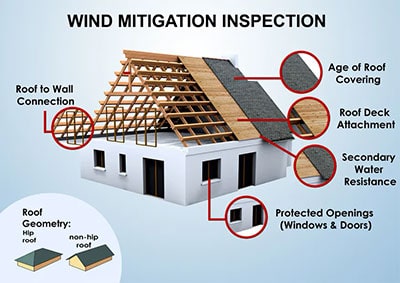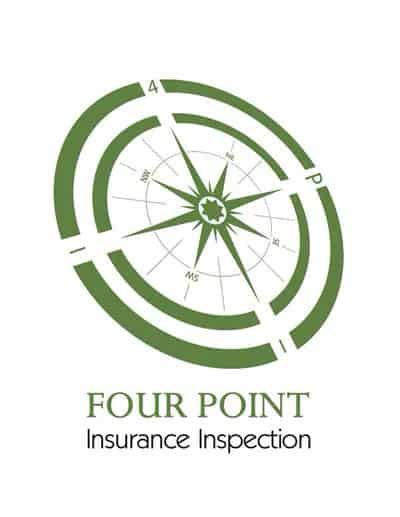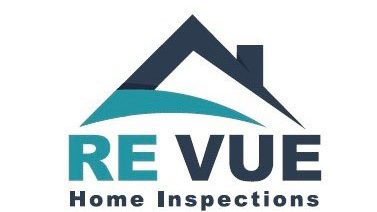Pricing starting as low as $149.99 – Additional cost of $50 for 4-Point Inspection and $50 for Wind Mitigation at the time of inspection. $100 for 4-point and $150 for wind mitigation if completed during separate site visit.
Buyer's Home Inspections
Buying a home is a big step and a buyer's inspection can reduce the risk of making a poor or costly decision. Brian will take you through a thorough inspection looking for areas of the property that are not performing correctly, are unsafe or may be problematic.
Wind Mitigation
The purpose of a windstorm inspection is to determine the appropriateness of a given structure's construction in the event of strong winds, such as those present in a hurricane.
4 Point Inspection
Insurance companies sometimes require an inspection of a house's roof and the HVAC, electrical and plumbing systems before providing homeowners insurance. This inspection is usually only required on homes which are 20–25 years old or older and is commonly required in Florida and other coastal states.
Maintenance / Pre-Listing
When you put a home up for sale it is nice to know beforehand, what you are going to have to fix to improve your chances of a good sale. When you provide a full inspection report upfront buyers are more confident moving forward.
New Construction
We can inspect your new home or building during or after construction providing you with “quality assurance" as to whether your builder is following the plans and best practices.
Moisture Problems
Brian will track down problems with water intrusion, or issues with excessive humidity and recommend simple, cost-effective solutions that will fix your problem in a timely manner.
What is the Wind Mitigation Inspection Form?
 What is the OIR-B1-1802 Uniform Mitigation Verification Inspection form? How does it apply to me as a homeowner in the State of Florida? How do I understand what the Inspector is looking for and how can I be sure they perform the inspection properly and complete the form accurately? These are the questions I hope to answer and more. If you have received notice from your insurance company that they require this type of inspection to quote your insurance, you will know what to expect and how the inspector should perform the inspection.
What is the OIR-B1-1802 Uniform Mitigation Verification Inspection form? How does it apply to me as a homeowner in the State of Florida? How do I understand what the Inspector is looking for and how can I be sure they perform the inspection properly and complete the form accurately? These are the questions I hope to answer and more. If you have received notice from your insurance company that they require this type of inspection to quote your insurance, you will know what to expect and how the inspector should perform the inspection.
The OIR-B1-1802 is a standardized form produced by the Office of Insurance Regulation (OIR) for the purpose of verifying mitigation features of a structure that help reduce the possibility of damage to the building during high wind conditions. Specifically, the form helps to recognize certain building practices that help strengthen a buildings structural and nonstructural features. Mitigation, in the simplest term, means to reduce or redistribute force.
The form is standard for the industry and is the same from one inspector to another. The history of the form goes back to the early 90’s right after Hurricane Andrew, if you installed Hurricane shutters on your home you could possibly get a credit from your insurer for having protected glazed openings (glazed = glass).
The form has changed significantly over the past 23 years. It has gone through multiple revisions, changes, and updates as new information and building codes have changed. The form in the current edition was last revised in 2012, and while it seems simple enough, it is very confusing and difficult to understand.
If you are a new homeowner, or a current homeowner thinking of switching your wind insurance policy provider, then you have most likely come in contact with this form. Insurers will ask for this type of inspection to quote your wind insurance, they will discount your policy premium based on the features you do have that qualify. The discounts are listed in the Florida Statutes and are required per state law, but that is the topic of an upcoming article.
When your insurer asks for this type of inspection they will generally refer a company or individual they are familiar with, this person will come to your residence and perform the inspection for a fee that you pay. Depending on the features that are present or not present, your insurance rates will be based upon present features in the form of discounts for verified mitigation components such as window protection, hip roof feature, roof coverings installed with a product approval, and roof deck/truss attachments to name a few. You can see how important proper completion of the form can be, it directly effects what you will be paying for your wind insurance.
The inspector will be looking for these features through visual inspection of the property and components along with documentation validating installation in the form of permits and Product Approvals/Notice of Acceptances used to confirm testing for compliance with building codes. Always make sure you have permits and documentation confirming compliance with building codes and approvals of installation as anything installed without the required permit is not verifiable and will not count towards the form. The inspection should take about one hour depending on the size of the property.
The inspector will require access to each attic space with an accessible hatch, the interior and exterior of the property, the roofing system, and attached garages along with any installed system that is stored (Hurricane Panels). You should plan on providing any information to confirm compliance and installation with building codes and permits to the inspector. They will use this information in the report to verify attributes you may get credit for depending on the component and product used.
What is a 4-Point Inspection?

If your home is 40 years or older you may have heard mention of a "4 Point Inspection" being needed before you will be able to obtain homeowners insurance. Older homes can have many systems that are not acceptable to the standards of insurers today or do not comply with current building and safety regulations. Unless the older home has undergone significant restoration, it is probable that many of these dated systems remain in the home.
That’s why it’s critical to have a 4 Point inspection done on the home before closing to make sure that it meets or exceeds the requirements for insurance.
The four point focuses only on four main area of your home.
- HVAC (Heating, Ventilation and Air Conditioning)
- Electrical Wiring and Panels
- Plumbing connections and fixtures
- Roof
When is a 4-point inspection required?
Depending on the insurance company, 4-point inspections are required for homeowner’s insurance policies (HO-3) and rental properties (DP-3) for older (30+ years) properties. 4-point inspections are not required for renter’s insurance policies (HO-4) or condominium policies (HO-6), regardless of the age of the property.
A 4-Point Inspection must be performed by either a Florida licensed general or building contractor, a building inspector, architect or engineer, OR a member of the American Society of Home Inspectors (ASHI), the Florida Association of Building Inspectors (FABI), or the National Association of Certified Home Inspectors (NACHI).
Four-point inspections sometimes include specific photos and details regarding the condition and materials used for the home’s electrical, heating/cooling, roof and plumbing systems. Typically, 4-point inspections must have been completed within the last 12 months to be accepted.
What causes the insurance company to request a 4-point inspection?
A: Depending on the insurance company, 4-point inspections are generally requested for homes 30 years and older. Some companies are more lenient and request a 4-point inspection for homes 40 or 50 years of age. Additionally, if the home is a foreclosure some companies will request a 4-point inspection regardless of age.
Will a 4-point inspection help lower your insurance costs?
A: FALSE. 4-Point inspections, regardless of the outcome, will not alter the cost of your homeowners insurance. Four-point inspections simply determine your home’s eligibility for insurance.
